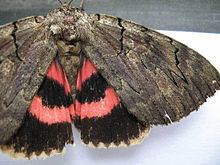Rank Species | Subphylum Hexapoda Genus Catocala Order Butterflies and moths | |
 | ||
Similar Catocala, Catocala amatrix, Catocala concumbens, Catocala blandula, Catocala subnata | ||
Catocala cara, the darling underwing, is an Erebidae species. The species can be found in the United States east of the Rocky Mountains; it occurs west at least to Oklahoma and north at least to Illinois. It also ranges into southern Canada, but only barely so.
Contents
Description and ecology
The wingspan is 70–85 mm. The forewings are dark purplish brown above, and light cream below. The hindwings have a deep scarlet-pink ground color with a pattern of two clean concentric blackish bands per wing, one through the midwing and one along the pale outer margin. The hindwing base is heavily covered in dark hairs; at a casual glance it may thus appear as if at the center of the dark bands there is a black spot or streak. As in many relatives, the foreleg tibia of this species possess no spines, while the tarsi carry three rows of spines.
The adult moths flies from June to October depending on the location. The caterpillars feed on Populus (poplar and cottonwood) and Salix (willow) species, especially Black willow (S. nigra).
Classification
This moth is placed in the subfamily Catocalinae, either of the owlet moth family, Noctuidae, or – if the Noctuidae are circumscribed more strictly – of family Erebidae. Within the Catocalinae, it belongs to tribe Catocalini and – if the Noctuidae are circumscribed widely – subtribe Catocalina.
The former subspecies C. c. carissima, which occurs to the south of the darling underwing, is now again considered to be a valid species Catocala carissima (Carissima underwing); this also includes the supposed species C. silvia, which actually is merely a form with no formal taxonomic standing.
